The Departments of Justice and Interior and Local Government are working out ways to decongest jails and prisons in the country that would initially entail updating and digitizing all jail records.
With the Bureaus of Corrections and Jail Management and Penology reporting congestion rates of as much as 300 percent in their jurisdictions, the Departments of Justice and Interior and Local Government would take the first step of addressing such congestion through updating and digitizing prison records or carpetas and constructing new facilities.
Once updated and digitized, those that have overserved their prison sentences can now be released or pardoned both aimed at decongesting jails and giving them justice that has long been denied them because of outdated record systems.
Justice Secretary Jesus Crispin Remulla and Interior Secretary Benhur Abalos Jr. met recently to discuss jail overcrowding often at many times their capacity.
Digitization
Remulla said he visited on Wednesday the Bureau of Pardons and Parole (BPP) and the Parole and Probation Administration PPA) and he saw carpetas physically being turned over to the offices.
There are more than 30,000 people detained at New Bilibid Prison alone. The number of PDLs in the country's prisons could reach 100,000, which would mean 100,000 folders for their files.
"If this manual [carpeta system] will continue, what will happen to those detained?" Remulla said.
The justice secretary said they also need more manpower in the BPP and PPA to process the releasing of PDLs, which would help decongest BuCor facilities.
Remulla added he already ordered the BuCor to speed up the digitization of carpetas despite initial resistance. "It’s the only way that we can really make things visible online for the BPP, PPA. We’re pushing for this," he continued.
Requirement
"It’s not a new thing, but for things that have been done for years as manual but we are imposing this as requirement," Remulla also said.
Remulla said he has also requested for an assistant secretary for digital infrastructure at the department for the digitization of processes from prosecution to correction.
DILG Secretary Abalos said they are also pushing for digitization of records and that the department is discussing it with the Department of Information Communications and Technology. He said this would help harmonize records in bureaus of the DILG and in the DOJ.
Need for land
Abalos said the BJMP, under their department, allocated P6.7 billion to improve and repair jail facilities.
But BJMP Jail Director Allan Iral admitted that they would also need property donations from the LGUs so they can build more facilities for detainees.
They will also focus on plea bargaining, which would allow defendants to plead guilty to a lesser crime for a shorter sentence.
Iral said they are also coordinating with the courts for fast-tracking of hearings to reduce the congestion rates of their facilities.
Abalos said they plan to go around jails across the country to ensure that they have a humane environment.
‘A face, not just a number’
Remulla, meanwhile, gave this reminder: "Every PDL should have a face to everybody, and not just a number."
BuCor — an agency under the DOJ that handles convicts with prison sentences of more than three years — has a jail congestion rate of 330 percent, while DILG’s BJMP, which manages prisons for those serving less than three years sentence and undergoing trial has a congestion rate of 387 percent.
At the onset of the pandemic, the government implemented measures to decongest jails where physical distancing and proper hygiene—deterrent to the spread of the coronavirus—are a luxury. Among those measures was reviewing cases to see which inmates and detainees could already be released from custody and speeding up the disposition of pending cases.
Tags: #DOJ, #DILG, #digitizingrecords, #decongestingjails, #PDLs, #justice
